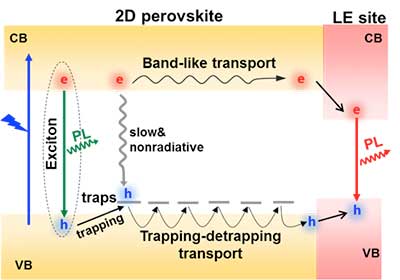| Aug 21, 2020 | |
Scientists reveal trap-enabled long-distance carrier transport in perovskite quantum wells(Nanowerk News) Layered two-dimensional (2D) hybrid perovskites are naturally-formed multiple quantum well (QW) materials. They are promising for applications in quantum and optoelectronic devices due to features like flexible structures, large exciton binding energy, readily tunable bandgap (thickness of QW) and prominently improved moisture resistance. |
|
| In previous reports, it is believed that the carrier diffusion distance is limited by a short exciton lifetime and small mobility, which may not be able to compete with three-dimensional (3D) perovskites and other traditional semiconductor QWs. | |
| Recently, a research team led by Prof. JIN Shengye and Prof. TIAN Wenming from the Dalian Institute of Chemical Physics (DICP) of the Chinese Academy of Sciences (CAS) reported trap mediated long-distance carrier transport beyond the limit of exciton in PEA2(MA)n-1PbnI3n+1 (n=2-4) single-crystals. The carrier diffusion distance could be as long as 2 to 5 µm, which was on the same order of 3D perovskites and other traditional semiconductor QWs. | |
| This work was published in J. Am. Chem. Soc. ("Trap-Enabled Long-Distance Carrier Transport in Perovskite Quantum Wells"). | |
 |
|
| Long-distance carrier transport in an exfoliated 2D perovskite crystal. (Image: ZHAO Chunyi and TIAN Wenming) | |
| The scientists observed the long-distance carrier transport beyond the limit of exciton in pure-phase layered 2D perovskites. By using time-resolved photoluminescence (PL) imaging microscope, they found that carriers in 2D perovskites travel in a nonluminescent (dark) state, making the transport process "unseen" by only collecting exciton emission. | |
| The presence of low-energy (LE) emission sites specifically locating at exfoliated crystals edges provided a unique spectroscopic handle for the scientists to observe such "dark" carrier transport. | |
| "We proposed the carrier transport mechanism that a portion of excitons underwent a fast dissociation process, generating a charge-separated state with hole at a trap state and electron at conduction band (CB)," said Prof. TIAN. | |
| The recombination of electron at CB with the trapped hole was slow (on hundreds of ns time scale) and nonradiative, thus enabling a long-range transport with little PL in the pathway. Once they reached a LE site, the electron and hole could be collected and turned into a luminescent state with LE PL. | |
| This unique property makes organic-inorganic hybrid 2D perovskites an ideal candidate for high-efficiency quantum and optoelectronic devices whose performance relies on a long-range carrier or energy flow. |
| Source: Chinese Academy of Sciences | |
|
Subscribe to a free copy of one of our daily Nanowerk Newsletter Email Digests with a compilation of all of the day's news. |
